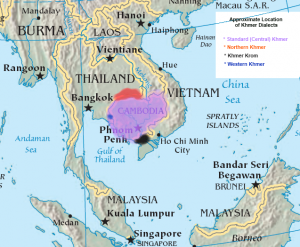By Sarah-Claire Jordan
 Bordering Thailand and Vietnam, Cambodia is a fascinating country with a rich history. It was once the home to the great Khmer Empire and has amazing architecture, usually in the form of Buddhist temples. More than 90% of the population practices a specific branch of Buddhism, and Khmer, or Cambodian, is the official language of the country. Khmer is also spoken in Vietnam and Thailand among other countries, but the majority of speakers reside in Cambodia.
Bordering Thailand and Vietnam, Cambodia is a fascinating country with a rich history. It was once the home to the great Khmer Empire and has amazing architecture, usually in the form of Buddhist temples. More than 90% of the population practices a specific branch of Buddhism, and Khmer, or Cambodian, is the official language of the country. Khmer is also spoken in Vietnam and Thailand among other countries, but the majority of speakers reside in Cambodia.
Khmer is the oldest written language in a branch of a very old language family
Though some linguists may disagree as to whether Khmer belongs in the Mon-Khmer branch of the Austroasiatic language family or deserves a branch of its own, they all agree that Khmer was being written before Mon and even Vietnamese. The first written records of Khmer can be dated back to the 7th century, and weren’t written using any other language’s script. The Khmer script is based on the Pallava script of India, but is very much its own writing system. Khmer is still written with this system to this day.
Khmer is both an analytic language and non-tonal.
Analytic languages are languages without inflection, that is to say, without verb endings that signify a different tense. Instead, tense is shown using particles or adverbs. A particle is placed in front of a verb to modify it, while adverbs easily change the tense by suggesting a time when the action was completed. Unlike the languages that surround it, Khmer is distinctly non-tonal except for one dialect, that of the capital city Phnom Penh. This dialect has two different “tones”, if one can call them such, that help to make up for the lack of the /r/ sound.
There are six main dialects of Khmer.
Speaking of dialects, Khmer has a wide range of them. The Phnom Penh dialect is unique with its tonality, and that it is used in the capital city and surrounding areas only. Khmer Khe is another dialect restricted to one area, that of Siem Pang district of the Stung Treng province. The rest of the dialects are divided up based on the region of the country they are spoken in. Khmer Krom, also called Southern Khmer, is spoken in a region so far south that it extends into Vietnam, as that particular region of Vietnam used to be controlled by the Khmer empire. Northern and Western Khmer are spoken in the north and west, while Standard or Central Khmer is spoken throughout the central part of the country and is also taught in schools and used in TV and radio broadcasts.
Khmer is spoken differently depending on who is talking to whom.
Just like its neighbor, Thai, Khmer uses different social registers. This means that the social position of the person talking and that of the person they are talking to dictates how they will speak to each other. There are six different registers: intimate/informal which is used for informal situations or when talking to someone of an inferior class, neutral, formal, one for everyday people to use to talk with a member of the Buddhist clergy as well as vice versa, and one for addressing royalty. All of these registers extend across all of the dialects and are very much respected and used to this day.
For an overview of our translation expertise, visit our technical translation service page.



